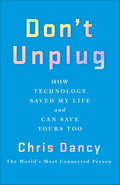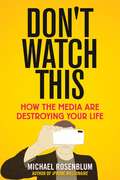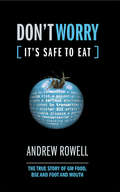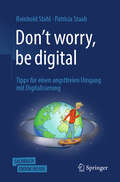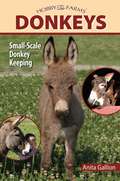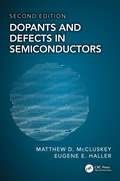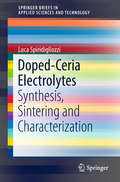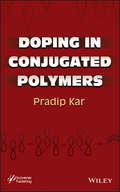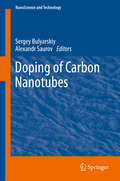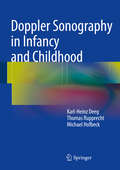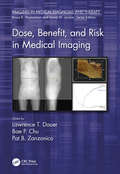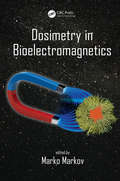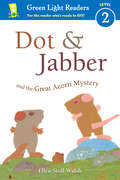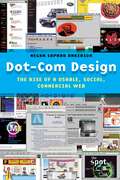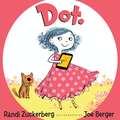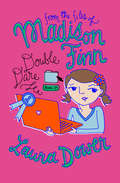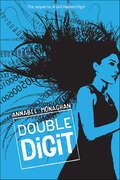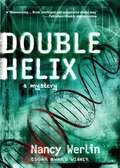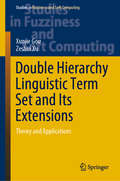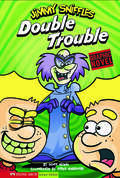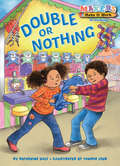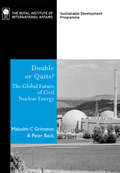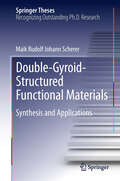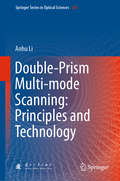- Table View
- List View
Don't Unplug: How Technology Saved My Life and Can Save Yours Too
by Chris DancyChris Dancy, the world's most connected person, inspires readers with practical advice to live a happier and healthier life using technologyIn 2002, Chris Dancy was overweight, unemployed, and addicted to technology. He chain-smoked cigarettes, popped pills, and was angry and depressed. But when he discovered that his mother kept a record of almost every detail of his childhood, an idea began to form. Could knowing the status of every aspect of his body and how his lifestyle affected his health help him learn to take care of himself? By harnessing the story of his life, could he learn to harness his own bad habits? With a little tech know-how combined with a healthy dose of reality, every app, sensor, and data point in Dancy's life was turned upside down and examined. Now he's sharing what he knows. That knowledge includes the fact that changing the color of his credit card helps him to use it less often, and that nostalgia is a trigger for gratitude for him. A modern-day story of rebirth and redemption, Chris' wisdom and insight will show readers how to improve their lives by paying attention to the relationship between how we move, what we eat, who we spend time with, and how it all makes us feel. But Chris has done all the hard work: Don't Unplug shows us how we too can transform our lives.
Don't Watch This: How the Media Are Destroying Your Life
by Michael RosenblumAn unfiltered look at the addictive properties of social media, TV, and movies on our culture, with strategies to help you reclaim control over your life. Today, the average person spends an astonishing eight hours a day watching TV or videos online. Watching social media stories, movies, and TV is now our number one activity, outpacing everything else that we do, including sleep. This habit has an incredibly powerful influence on our lives – from what we think to what we buy to whom we elect. Media are more than entertainment; they are a drug. This media addiction wreaks havoc on our mental health, causing increased stress, depression, and anxiety, and ruining personal relationships. It also drives us deeper and deeper into debt. In Don&’t Watch This, former TV producer and Ivy League professor Michael Rosenblum reveals the hidden psychology driving us to media addiction. He describes why solving the problem is not as simple as swearing off our devices, but about learning how to use media for good. Rosenblum reveals the key to getting the best out of technology, without letting it get the best of you. Inside, you&’ll learn: How to take control of the mediaHow to use your phone&’s camera to spread stories worth tellingHow having a former reality TV star in the Oval Office has changed the scope of mediaWhy posting selfies on Instagram isn&’t going to change the world, and what you can post instead Enlightening and empowering, Don&’t Watch This provides actionable, revolutionary techniques and insight to control your media addiction—helping you live the life you really want.
Don't Worry (It's Safe to Eat): The True Story of GM Food, BSE and Foot and Mouth
by Andrew RowellAn investigation of science, politics and our food production system, this text exposes the bogus science, political interference and flawed policies that threaten our food supply. The author tells the story of BSE, revealing how top scientists have been muzzled and how the epidemic continues. Then, against a backdrop of burning cows, Andrew Rowell exposes how trade and macro-economic policies overruled good science in the foot and mouth catastrophe. He also opens the black box of the so-called GM revolution to expose the myth behind the marketing. In tracing how critics are silenced in the bottom-line climate of commercialized science and privatized knowledge, Rowell tells the true story of the widely publicized Pusztai GM potato scandal of the late 1990s and the ongoing Mexican maize GM contamination affair. Finally, the book offers radical solutions to make science work in the public interest and provide food that really is safe to eat.
Don't worry, be digital: Tipps für einen angstfreien Umgang mit Digitalisierung
by Reinhold Stahl Patricia StaabFühlen Sie sich überfordert angesichts der vielen Informationen, Meinungen und Unterhaltungsangebote im Internet? Ist Ihnen die zunehmende Digitalisierung in allen Lebensbereichen manchmal eher unheimlich? Überlegen Sie, wie weit Sie dabei mitmachen sollen? Dieses Buch lädt Sie ein, entspannt(er) mit dem technischen Fortschritt umzugehen. Die Digitalisierung macht unser Leben an vielen Stellen leichter, vielfältiger und sicherer: Heute können wir so leicht wie nie zuvor mit Leuten aus allen Ecken der Welt kommunizieren. Dank der vielen elektronischen Hilfen ist Autofahren sicherer denn je geworden und elektronische Helfer nehmen uns inzwischen viele lästige Arbeiten ab. Unterhaltsam und mit hilfreichen Tipps und einer positiven Grundhaltung gehen die Autoren auf verschiedene Lebensbereiche ein. Sie erläutern anschaulich, wie sich die digitale Entwicklung auf unseren Alltag auswirkt, und geben Tipps, wie man angstfrei damit umgehen kann. Von A wie Arbeiten über G wie Gesundheit und K wie Künstliche Intelligenz bis Z wie Zahlungsmittel finden Sie hier Informationen zu zahlreichen Themen des Lebens und der Digitalisierung. Aber auch die Risiken und Nebenwirkungen bleiben nicht unerwähnt. Die Autoren greifen Beispiele aus der Tagespresse auf und geben Hinweise für den sorgfältigen Umgang mit Sozialen Medien, persönlichen Daten und „Fake News“. Dabei bleibt der Text immer verständlich und illustriert mit Geschichten und Zeichnungen, statt Sie mit Statistiken zu überladen.
Donkeys
by Anita GallionThere's never been a better time to add donkeys to a small-scale farm. Friendly, dependable, intelligent, and easy to care for, donkeys are increasingly prized by small-scale farmers. As with tending any livestock, it is always best for the keeper to be prepared. Whether you're an experienced breeder or a new hobby farmer, this book provides information about the ins-and-outs of buying, caring for, and enjoying these terrific stable companions. Every donkey keeper will gather a bushel of essential information on keeping these remarkable creatures from this colorful new addition to the Hobby Farms series.
Dopants and Defects in Semiconductors
by Matthew D. McCluskey Eugene E. HallerPraise for the First Edition "The book goes beyond the usual textbook in that it provides more specific examples of real-world defect physics … an easy reading, broad introductory overview of the field" ―Materials Today "… well written, with clear, lucid explanations …"―Chemistry World This revised edition provides the most complete, up-to-date coverage of the fundamental knowledge of semiconductors, including a new chapter that expands on the latest technology and applications of semiconductors. In addition to inclusion of additional chapter problems and worked examples, it provides more detail on solid-state lighting (LEDs and laser diodes). The authors have achieved a unified overview of dopants and defects, offering a solid foundation for experimental methods and the theory of defects in semiconductors. Matthew D. McCluskey is a professor in the Department of Physics and Astronomy and Materials Science Program at Washington State University (WSU), Pullman, Washington. He received a Physics Ph.D. from the University of California (UC), Berkeley. Eugene E. Haller is a professor emeritus at the University of California, Berkeley, and a member of the National Academy of Engineering. He received a Ph.D. in Solid State and Applied Physics from the University of Basel, Switzerland.
Doped-Ceria Electrolytes: Synthesis, Sintering And Characterization (SpringerBriefs in Applied Sciences and Technology)
by Luca SpiridigliozziThis book provides an overview of fuel cell technology and, in particular, of Solid Oxide Electrolysis Cells (SOFCs). Each chapter highlights the effects of different synthesis parameters and/or adopted sintering method, clarifying both advantages and disadvantages pointed out by different experimental campaigns. The book focuses on Doped-Ceria Electrolytes, presenting an engineered production process of GDC/SDC electrolytes by using a combination of wet chemical synthesis and/or alternative sintering techniques, capable of enhancing electrolytes microstructural features and electrical properties at reduced temperature and time. The author proposes useful guidelines to produce dense and high-preforming ceria-based electrolytes for IT-SOFCs.
Doping in Conjugated Polymers (Polymer Science and Plastics Engineering)
by Pradip KarAn A-to-Z of doping including its definition, its importance, methods of measurement, advantages and disadvantages, properties and characteristics—and role in conjugated polymers The versatility of polymer materials is expanding because of the introduction of electro-active behavior into the characteristics of some of them. The most exciting development in this area is related to the discovery of intrinsically conductive polymers or conjugated polymers, which include such examples as polyacetylene, polyaniline, polypyrrole, and polythiophene as well as their derivatives. "Synmet" or "synthetic metal" conjugated polymers, with their metallic characteristics, including conductivity, are of special interest to researchers. An area of limitless potential and application, conjugated polymers have sparked enormous interest, beginning in 2000 when the Nobel Prize for the discovery and development of electrically conducting conjugated polymers was awarded to three scientists: Alan J. Heeger, Alan G. MacDiarmid, and Hideki Shirakawa. Conjugated polymers have a combination of properties—both metallic (conductivity) and polymeric; doping gives the conjugated polymer's semiconducting a wide range of conductivity, from insulating to low conducting. The doping process is a tested effective method for producing conducting polymers as semiconducting material, providing a substitute for inorganic semiconductors. Doping in Conjugated Polymers is the first book dedicated to the subject and offers a comprehensive A-to-Z overview. It details doping interaction, dopant types, doping techniques, and the influence of the dopant on applications. It explains how the performance of doped conjugated polymers is greatly influenced by the nature of the dopants and their level of distribution within the polymer, and shows how the electrochemical, mechanical, and optical properties of the doped conjugated polymers can be tailored by controlling the size and mobility of the dopants counter ions. The book also examines doping at the nanoscale, in particular, with carbon nanotubes. Readership The book will interest a broad range of researchers including chemists, electrochemists, biochemists, experimental and theoretical physicists, electronic and electrical engineers, polymer and materials scientists. It can also be used in both graduate and upper-level undergraduate courses on conjugated polymers and polymer technology.
Doping of Carbon Nanotubes
by Sergey Bulyarskiy Alexandr SaurovThis book addresses the control of electronic properties of carbon nanotubes. It presents thermodynamic calculations of the formation of impurities and defects in the interaction of nanotubes with hydrogen, oxygen, nitrogen and boron, based on theoretical models of the formation of defects in carbon nanotubes. It is shown that doping and adsorption lead to changes in the electronic structure of the tubes as well as to the appearance of impurity states in the HOMO-LUMO gap. The book presents examples of specific calculations for doping of carbon nanotubes with oxygen, hydrogen, nitrogen and boron, together with numerous experimental results and a comparison with the author's thermodynamic calculations. Possible directions of the technological processes of optimization are pointed out, as well as the perspectives of p-n-transition creation with the help of carbon nanotube arrays. The results presented were derived from the physics of the processes and a theoretical model of the technological processes. Though a wealth of empirical information on doping nanotubes has been accumulated in the scientific literature, what is lacking is a theoretical model for their analysis. As such, the book develops a thermodynamic model of the self-organization of structural elements in multicomponent systems - including carbon nanotubes, clusters and precipitates in condensed matter - and subsequently adapts it to the doping of carbon nanotubes. This approach allows readers to gain a far deeper understanding of the processes of doping carbon nanotubes.
Doppler Sonography in Infancy and Childhood
by Karl-Heinz Deeg Thomas Rupprecht Michael HofbeckThis book covers the full range of current applications of Doppler sonography in infancy and childhood, describing the variety of potential findings with the aid of a wealth of images. After an introductory chapter on the physical and technical basis of Doppler sonography, applications of cerebral Doppler sonography in infancy and of transcranial Doppler sonography in childhood are addressed, with numerous examples of imaging appearances. The major part of the book is devoted to Doppler sonography of the brain, face and neck and of the abdomen, covering normal abdominal vessels, liver, spleen, pancreas, and mesenteric and renal circulation. Imaging of the ovaries and testes is also presented, encompassing the differential diagnosis of acute scrotum and other space-occupying lesions of the testis. The book closes by considering Doppler sonography of soft tissue and vascular malformations, and the influence of congenital heart malformations on flow parameters in peripheral arteries. Doppler Sonography in Infancy and Childhood will be an invaluable reference for pediatricians, neonatologists, pediatric sonographers, and pediatric and general radiologists.
Doppler Ultrasound in Obstetrics and Gynecology
by Dev Maulik Christoph C. LeesExpanded and updated edition highlighting current standards and breakthroughs in the technology of Doppler ultrasound Includes latest advances in 3D and color doppler and 4D fetal echocardiography Includes more than 500 illustrations, including more than 150 in color
Dose, Benefit, and Risk in Medical Imaging (Imaging in Medical Diagnosis and Therapy)
by Lawrence T. Dauer Bae P. Chu Pat B. ZanzonicoThis timely overview of dose, benefit, and risk in medical imaging explains to readers how to apply this information for informed decision-making that improves patient outcomes. The chapters cover patient and physician perspectives, referral guidelines, appropriateness criteria, and quantifying medical imaging benefits. The authors have included essential discussion about radiologic physics in medical imaging, fundamentals of dose and image quality, risk assessment, and techniques for optimization and dose reduction. The book highlights practical implementation aspects with useful case studies and checklists for treatment planning. Clinicians, students, residents, and professionals in medical physics, biomedical engineering, radiology, oncology, and allied disciplines will find this book an essential resource with the following key features: Discusses risk, benefit, dose optimization, safety, regulation, radiological protection, and shared & informed decision-making. Covers regulatory oversight by government agencies, manufacturers, and societies. Highlights best practices for improving patient safety and outcomes. Gives guidelines on doses associated with specific procedures.
Dosimetry in Bioelectromagnetics
by Marko MarkovDosimetry refers to the calculation and assessment of the radiation dose received by the human body. The proposed book will place emphasis on the existence of physical and biophysical dosimetry. It will be discussed for the proper description and evaluation of the signal at the power generation system. It will cover in detail 10 different parameters of EMF (electromagnetism) exposure such as amplitude, frequency, vector, time of exposure, orientation, etc. In most published papers, these parameters are not well defined.
Dot & Jabber and the Great Acorn Mystery (Dot & Jabber)
by Ellen Stoll WalshDot and Jabber are mouse detectives with a mission: They’re determined to find out how a little oak tree grew in their field when there are no other oak trees around. They know it grew from an acorn, but how did the acorn get there? Dot and Jabber have a case to crack--if Jabber doesn’t eat the clues first! Ellen Stoll Walsh, creator of the popular Mouse Paint mice, introduces two new mice who love mysteries. Full of curiosity and humor, Dot and Jabber track clues to solve science mysteries for young readers. An afterword presents easy-to-understand facts about acorns and oak trees.
Dot-Com Design: The Rise of a Usable, Social, Commercial Web (Critical Cultural Communication #15)
by Megan Sapnar AnkersonFrom dial-up to wi-fi, an engaging cultural history of the commercial web industryIn the 1990s, the World Wide Web helped transform the Internet from the domain of computer scientists to a playground for mass audiences. As URLs leapt off computer screens and onto cereal boxes, billboards, and film trailers, the web changed the way many Americans experienced media, socialized, and interacted with brands. Businesses rushed online to set up corporate “home pages” and as a result, a new cultural industry was born: web design. For today’s internet users who are more familiar sharing social media posts than collecting hotlists of cool sites, the early web may seem primitive, clunky, and graphically inferior. After the dot-com bubble burst in 2000, this pre-crash era was dubbed “Web 1.0,” a retronym meant to distinguish the early web from the social, user-centered, and participatory values that were embodied in the internet industry’s resurgence as “Web 2.0” in the 21st century. Tracking shifts in the rules of “good web design,” Ankerson reimagines speculation and design as a series of contests and collaborations to conceive the boundaries of a new digitally networked future. What was it like to go online and “surf the Web” in the 1990s? How and why did the look and feel of the web change over time? How do new design paradigms like user-experience design (UX) gain traction? Bringing together media studies, internet studies, and design theory, Dot-com Design traces the shifts in, and struggles over, the web’s production, aesthetics, and design to provide a comprehensive look at the evolution of the web industry and into the vast internet we browse today.
Dot.
by Randi Zuckerberg*NOW A HIT TV SERIES*Meet Dot in this debut picture book by CEO and founder of Zuckerberg Media, editor-in-chief of Dot Complicated, and former Marketing Director of Facebook, Randi Zuckerberg! Dot's a spunky little girl well versed in electronic devices—she’s a technophile. She knows how to tap . . . to swipe . . . to share . . . and she pays little attention to anything else.Dot's tech-savvy expertise, mingled with her resourceful imagination, proves Dot knows lots and lots.But will she be able to unplug for one second to tap…swipe…and share with her real-life friends? Find out in this wonderful story about the day when Dot sets off on an interactive adventure with the world surrounding her.
Double Dare (From the Files of Madison Finn #14)
by Laura DowerIt&’s Madison vs. Egg when the school computer contest turns competitive!Madison assumes that she and her best guy friend, Egg, will partner up for the &“I Can Do That!&” computer contest to create a web page for homework help. So when Egg chooses Chet as his partner, Maddie feels hurt. Their love of computers has always bonded them together. Fiona offers to be Madison&’s partner, and Egg throws down a challenge: He double dares the girls to try to win against the boys. Madison embraces the challenge—she really wants to show off her computer skills. Or does she just want to beat Egg at his own game?
Double Digit (Digit Series)
by Annabel MonaghanTo say eighteen-year-old Farrah Higgins—or Digit—is good at math is a laughable understatement. She’s been cracking codes since childhood, and is finally at home with “her people” at MIT in Cambridge. Her talents are so off the charts that her laptop is under surveillance by both the CIA and an ecoterrorist named Jonas Furnis. So when she thoughtlessly hacks into the Department of Defense’s database, she lands in serious hot water inside and outside the law. Readers will be sad to turn the last page of this suspenseful, sassy, super smart thriller, the sequel to A Girl Named Digit.
Double Helix
by Nancy WerlinEli has lucked into a job at Wyatt Transgenics offered to him by Dr. Wyatt, the famed scientist. The salary is substantial, the work is interesting, and Dr. Wyatt seems to be paying special attention to Eli. It's almost too good to be true. Is there a catch? Eli's father is vehemently against his taking the job, but won't explain why. Eli knows that there's some connection between Dr. Wyatt and his parents, something too painful for his father to discuss. Something to do with his mother, who is now debilitated by Huntington's disease. As he continues to work at the lab, and to spend time with Dr. Wyatt, he begins to uncover some disconcerting truths about himself, about his very makeup. Rich and suspenseful, with a hair-raising conclusion, this is Nancy Werlin's most dynamic novel yet, one that explores the ethics and amazements of genetic engineering.
Double Hierarchy Linguistic Term Set and Its Extensions: Theory and Applications (Studies in Fuzziness and Soft Computing #396)
by Zeshui Xu Xunjie GouThis book presents the concept of the double hierarchy linguistic term set and its extensions, which can deal with dynamic and complex decision-making problems. With the rapid development of science and technology and the acceleration of information updating, the complexity of decision-making problems has become increasingly obvious. This book provides a comprehensive and systematic introduction to the latest research in the field, including measurement methods, consistency methods, group consensus and large-scale group consensus decision-making methods, as well as their practical applications. Intended for engineers, technicians, and researchers in the fields of computer linguistics, operations research, information science, management science and engineering, it also serves as a textbook for postgraduate and senior undergraduate university students.
Double Trouble (Jimmy Sniffles)
by Scott NickelJimmy Sniffles archenemy devises a plan to create an evil twin from Jimmy's nose hair. Written in graphic-novel format.
Double or Nothing: A Makers Story about 3D Printing (Makers Make It Work)
by Catherine DalyMason and Mia are twins . . . but don&’t always get along. When Mia wins a dolphin at the fair, Mason really, really wants one, too. If only Mia could make a twin dolphin! This story explores the Makers theme of 3D Printing and helps young makers understand how it works and get excited to try it for themselves! Mia and Mason are able to make a 3D scan of the dolphin to create a 3D model, and use a special kind of melted plastic to create the three-dimensional design. Tying into the popular Makers Movement, Makers Make It Work is a series of fun easy-to-read stories that focus on problem-solving and hands-on action. *Bonus Activity in the Book: Draw a picture of your favorite animal from each side—a 2D drawing, then use it to create a 3D model.
Double or Quits?: The Future of Civil Nuclear Energy
by Peter Beck Malcolm C. GrimstonGlobal energy demand is likely to rise substantially by the mid-21st century. At the same time, the use of fossil fuels may need to be severely curtailed to reduce the emission of greenhouse gases. Nuclear power is one of the few options that meet these conflicting requirements. However, its potential to do so is an issue of wide disagreement and high emotions, with balanced information hard to find. This text, the culmination of a two-year study, provides a dispassionate and objective assessment of the major disputes on the future role of this controversial fuel. Decisionmakers and their advisers, as well as proponents and opponents of the fuel, should find that this book provides clarification of the main issues influencing the future of nuclear energy: relative economics, public perceptions and the process of decisionmaking, nuclear research and development, waste management, reprocessing and proliferation, nuclear safety and nuclear power and the Kyoto Protocol. In the light of the many uncertainties in the field of energy, the relevance of these issues can only continue to grow.
Double-Gyroid-Structured Functional Materials: Synthesis and Applications
by Maik Rudolf SchererThe development of new high-tech applications and devices has created a seemingly insatiable demand for novel functional materials with enhanced and tailored properties. Such materials can be achieved by three-dimensional structuring on the nanoscale, giving rise to a significant enhancement of particular functional characteristics which stems from the ability to access both surface/interface and bulk properties. The highly ordered, bicontinuous double-gyroid morphology is a fascinating and particularly suitable 3D nanostructure for this purpose due to its highly accessible surface area, connectivity, narrow pore diameter distribution and superb structural stability. The presented study encompasses a wide range of modern nanotechnology techniques in a highly versatile bottom-up nanopatterning strategy that splits the fabrication process into two successive steps: the preparation of mesoporous double-gyroid templates utilizing diblock copolymer self-assembly, and their replication with a functional material employing electrochemical deposition and atomic layer deposition. The double-gyroid structured materials discussed include metals, metal oxides, and conjugated polymers, which are applied and characterized in high-performance devices, such as electrochromic displays, supercapacitors, chemical sensors and photovoltaics. This publication addresses a wide range of readers, from researchers and specialists who are professionally active in the field, to more general readers interested in chemistry, nanoscience and physics.
Double-Prism Multi-mode Scanning: Principles and Technology (Springer Series in Optical Sciences #216)
by Anhu LiThis book introduces double-prism multi-mode scanning theory and technology, focusing on double Risley-prism, multi-mode scanning models, methods and key techniques applied in multi-mode optical scanning and target tracking fields. It is first book to systematically and comprehensively describe basic multi-mode scanning theory and practical implementation techniques utilizing double Risley prisms. It includes rigorous modeling of double Risley-prism multi-mode scanning systems and high-efficiency solution algorithms for inverse problems with abundant illustrative examples and scanning error analyses, along with design guidance and performance test on specific scanning devices. Further, it presents the latest research results for forward scanning models and inverse tracking algorithms, sub-microradian fine scanning modeling with tilting double Risley prisms, nonlinear control strategy for double prism motion, calibration and experiment techniques for various double-prism layouts, as well as opto-mechanical system design and analysis. Featuring rigorous theoretical derivations illustrated with corresponding examples and original scanning apparatus, the book is a valuable reference resource for those developing and applying multi-mode scanning techniques in photoelectric scanning and tracking areas.
